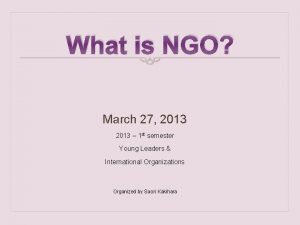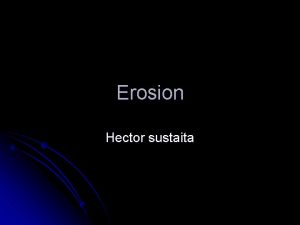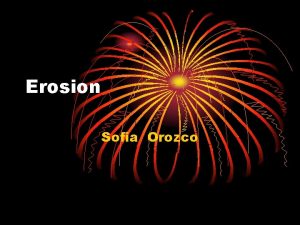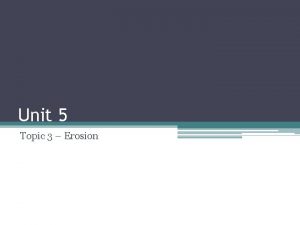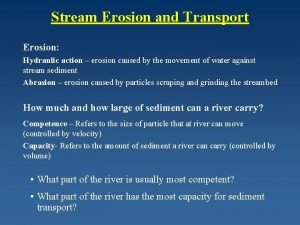Erosion Savannah Murphy 4 Stone March 13 2013






- Slides: 6

Erosion Savannah Murphy 4 -Stone March 13, 2013

What is Erosion is when Earth is worn away often by water, wind, or ice. Water, wind, or glaciers pick up sediment from Earths surface and move them around. Plant rocks hold sand or soil together against the effects of wind and water. Streams or rivers wear away the banks and create larger and larger valleys.

Floods Do you know what a flood is? If not I’ll tell you. A flood is when water overflows land that’s usually dry. The most common way is when rivers or streams overflow their banks. Too much rain cause rivers to overflow. Ice and snow that melts too quickly can cause a flood. Large rain amounts can also cause flooding. Coastal flooding happens when a large storm or tsunami causes the sea to surge inland. Flash flooding is very fast flooding. Flash flooding happens when a slow-moving thunderstorm stays in one place. Flash flooding also can be caused when two or more storms travel through the same area. Most floods take hours or even days to develop but flash floods develop quickly and with little warning. These flash floods can be tremendously dangerous. It can turn a babbling brook into a thundering wall of water sweeping everything in its path downstream. Now to tell you the effects of erosion. Excessive rain, a ruptured dam or levee, rapid melting ice in the mountains, or even a beaver dam can overwhelm a river and send it spreading over the adjacent land, called a floodplain. Floods can destroy neighborhoods, farmlands, roads, and even homes too.

Rock Falls A rock fall is pebble, rock, and dirt loosened by freezing, weathering, and other forces all fall downward, until something stops their descent. Tectonic stresses (strained) and erosion cause rocks to brake. Rock falls later happen along these fractures. This causes mechanisms like water, ice, earthquakes, and vegetation create the final forces that cause unstable rocks to fall. If water fractures in bedrock, it smoothens surfaces and can build up pressure behind unstable rocks. Water may also seep into cracks in the rock and freeze, causing the fractures in the rock to expand. This is called “frost wedging” or “freeze-thaw. ” It can lever loose rocks away from cliff faces. Ground shaking during earthquakes. Vegetation-most especially firs, pines, and canyon live oaks-grow into the sheer rock faces where their roots expand pry apart joints in the rock.

Sinkholes are land that gives in. Sinkholes occur from movement underground. The water first eats away the rock slowly. Then a big cave replaces the rock. Last The cave gets filled with ground water. A natural hole that forms in the Earth’s surface as a result of the chemical weathering of carbonate rocks like limestone, as well as salt beds or rocks that can be severely weathered as water runs through them. Water can drain through a sinkhole into a underground cave or channel. When mud or garbage plugs one of these underground caves, it fill with water to become a lake or pond.

Sources u u u http: //enviroment. nationalgeographic. com/en viroment/natural-disasters/flood-profile/ yosemitenationalpark. com Natures Power by Patricia K. Kummer





